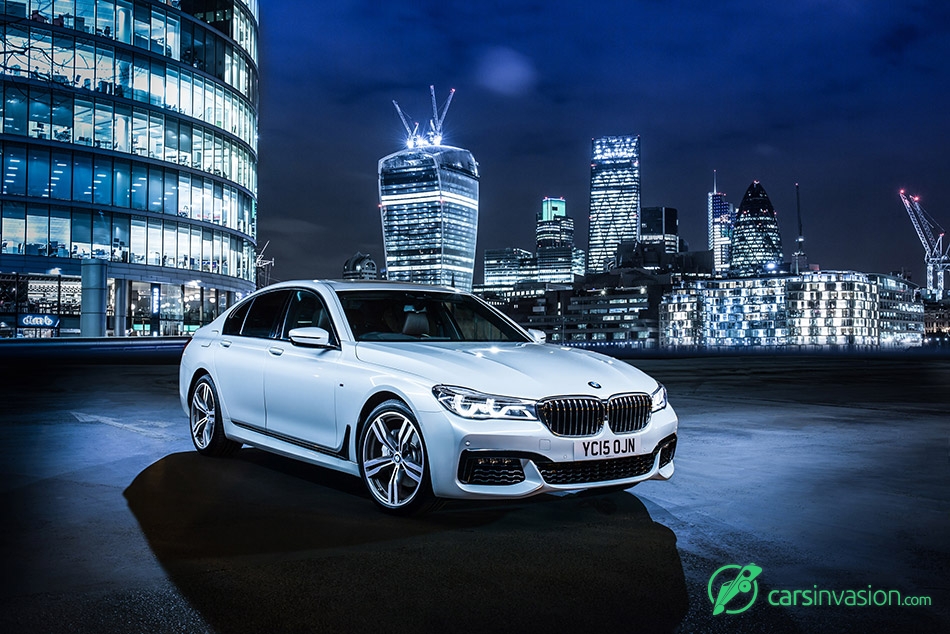The sixth generation of the BMW 7-Series is a true flagship of the BMW range, blending comfort, style, dynamic ability and cutting edge technology in equal measure to create an inspiring mode of luxury transport.
Thanks to the intelligent use of multiple materials in the construction of the body, including carbon-fibre reinforced plastic (CFRP) for the Carbon Core, the new BMW 7-Series is both stronger and up to 130kg lighter than its predecessor. This advanced construction is complemented by six-cylinder petrol and diesel engines taken from the latest generation of BMW power units.
With a wealth of interior comfort and driving features, from new ConnectedDrive technology to the sumptuous Executive Lounge feature, the new BMW 7-Series redefines luxury on the move.
Exterior Design: presence and elegance in harmony
The design of the new BMW 7-Series is a thoroughly modern interpretation of luxury. Every detail has been executed with meticulous precision, clearly positioning the new BMW 7-Series as the flagship model of the current BMW range: a car of elegance, refinement, advanced technology and high quality workmanship.
Like its predecessor, the new BMW 7-Series is offered in two body variants. The wheelbase of the extended version is 14cm longer, at 3,210mm and offers extra rear space as a result. At 5,098mm in total length (long-wheelbase version: 5,238mm), 1,902mm in width (excluding mirrors) and 1,478mm (1,485mm) in height, the new BMW 7-Series is the largest series-produced car the brand has ever built. Both body variants display familiar BMW proportions, characterised by a long bonnet, short front overhang, long wheelbase and a set-back passenger compartment. A smoothly downward-sloping roofline adds a hint of sportiness.
From the front, the new BMW 7-Series radiates a feeling of assured presence. It is the brand's first car to feature an Active Air Stream kidney grille, improving aerodynamics as well as making a strong visual statement. The headlight units extend up as far as the grille, while the light graphic of the familiar BMW twin circular headlights is levelled off at its upper and lower edges. The headlights have a precisely detailed design that portrays the sophisticated technology within both in standard full LED form and when optional BMW Laserlights are specified. The lower air intake stretched wide across the front end, the chrome bars in the outer edges of the intake and the horizontal contours of the LED fog lamps underline the car's broad-set stance.
Viewed in profile the new BMW 7-Series is defined by outward curving surfaces and a double swage line. The wrap-around window frame, taking in the Hofmeister kink, is a single-piece element for the first time in a series-produced model, while the Air Breather surround in the front side panel spawns a chrome trim strip which runs along the lower edge of the doors, emphasising a low centre of gravity. The exterior mirrors appear to grow organically out of the window frame, a slender stalk providing the sole connection between mirrors and car body.
The double swage line extends into the upper contour of the body and the light strips of the rear lights. All the light sources for the tail lights feature LED technology, with both L-shaped light units connected by a chrome bar that extends the full width of the rear end.
Two non-metallic and nine metallic colour shades are available for the exterior paintwork of the new BMW 7-Series. Another two variants can be ordered exclusively in conjunction with the M Sport package and also one BMW Individual special paint finish completing the set. Depending on the model variant, the new BMW 7-Series comes as standard with either 18- or 19-inch light-alloy wheels, while the options list and Original BMW Accessories range offer a selection of other light-alloy wheels in 18- to 21-inch sizes.
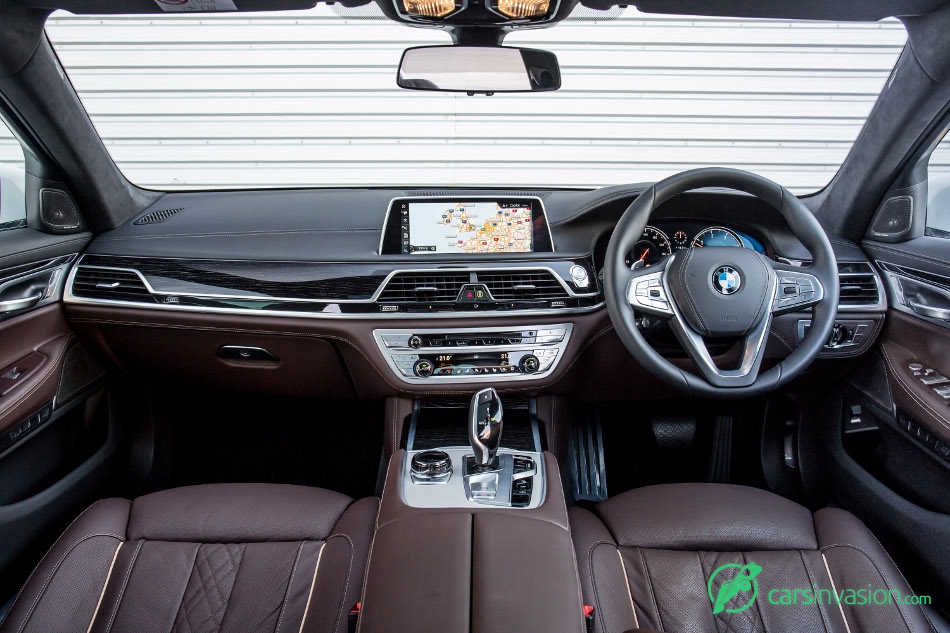
The interior design: a beautiful environment
The balance of dynamics and comfort so central to the new BMW 7-Series' character is reflected in the design of the interior. Whether it's the driving pleasure generated from behind the wheel, or the sublime sense of well-being when sat in the rear seats, the ambience of the new BMW 7-Series is both modern and luxurious. All the control and display elements share a new design that highlights their innovative functionality - such as the chrome buttons on the multifunctional steering wheel and centre console, and the touchscreen surface for the control panel of the Automatic air conditioning with 4-zone control.
The controls on the centre console are - like the interior trim strip - framed by fine wood or aluminium surfaces. Both the trim strips and the instrument panel's chrome surrounds which border them are made individually for each car; their dimensions are therefore matched to the nearest millimetre. The standard and optional equipment items are crafted from carefully selected materials and with the build quality expected of precision craftsmanship. Meanwhile, the generous levels of space on board are highlighted by a horizontal surface structure that extends through the door trim. Customers can choose from six colour variants for the standard Exclusive Nappa leather upholstery.
Furthermore, the Design Pure Excellence package, which is available separately for both the exterior and the interior, features an additional chrome strip above the front fog lamps, high gloss back-painted brake callipers and a chrome strip for the rear apron. An Alcantara headliner, fine wood inlays for the seat belt outlet covers, armrest and roof grab handles in the rear embellish the interior. On long wheelbase models the Design Pure Excellence exterior package is standard whilst the optional interior package also includes deep-pile floor mats for the rear compartment.
The M Sport models include an M aerodynamic body styling package comprising model-specific front/rear aprons and side skirts, plus 19-inch M light-alloy wheels in twin-spoke design, illuminated door sill finishers bearing the M logo and accents in either light or dark chrome. Inside there's a BMW Individual headliner in Anthracite and Fineline black wood interior trim strips with high-gloss metal effect.
BMW EfficientDynamics: lighter, stronger, more advanced
The advances achieved with the latest generation of the BMW 7-Series succeed in resolving a number of traditionally conflicting aims: the car comes with an array of new innovations but weighs less, performance is more dynamic but fuel consumption has been reduced, and while it is more luxurious than ever, emissions are lower. This ground-breaking evolution is due to BMW EfficientDynamics technology, comprising the most diverse range of measures ever to have been implemented in a production BMW. The unrivalled expertise derived from the development of BMW i cars has successfully been harnessed.
Careful material selection, energy-efficient production processes and further improved arrangements for environmentally friendly recycling help the new BMW 7-Series to obtain an exemplary life cycle assessment covering its entire product life. The environmental impact - the "greenhouse potential" - is around 25 per cent lower than in the outgoing model.
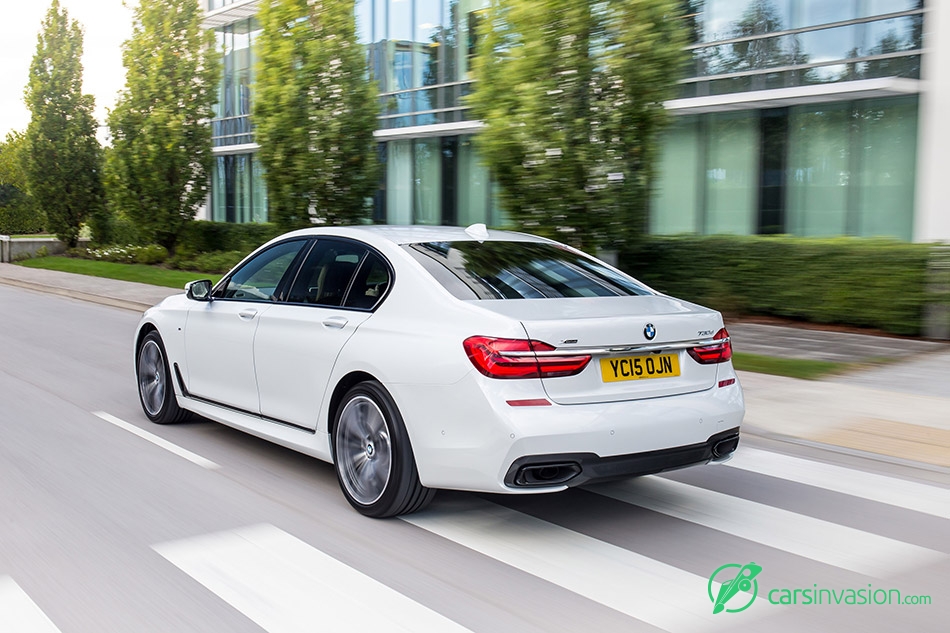
The BMW EfficientLightweight concept means that the models in the new BMW 7-Series line-up are up to 130kg lighter than their predecessors, despite boasting a significantly greater number of comfort and safety features. The key element here is the special body structure known as the Carbon Core. Thanks to its composite construction featuring CFRP, ultra-high-tensile steels and aluminium, the intelligent body design succeeds in increasing the strength and rigidity of the passenger cell while also bringing about a substantial reduction in vehicle weight. By using a hybrid construction of CFRP with ultra-high-tensile steels for structural elements, such as those in the vicinity of the B-pillars, the design of the sheet-metal components can be adapted to save weight.
The Carbon Core body is based on technology transferred from BMW i car development. The new BMW 7-Series is the first ever vehicle in which industrially manufactured CFRP is used together with steel and aluminium. It combines with the use of aluminium for specific sections of the body and chassis along with the systematic improvement of smaller details. Apart from the doors, the bootlid is also made from aluminium for the first time, and its use for assorted suspension components reduces the unsprung masses by as much as 15 per cent - to the benefit of suspension comfort. The vehicle's centre of gravity is now even lower, and the load is distributed 50:50 between the two axles for perfect balance.
Engines: a new generation 'sixes'
The six-cylinder in-line engines, with BMW TwinPower Turbo technology, that are fitted in the new BMW 7-Series range stem from the BMW Group's latest generation of engines. The 3.0-litre petrol unit under the bonnet of the BMW 740Li produces an output of 326hp, 7hp more than the engine it replaces. The new power unit's crankcase, cylinder head and oil sump are all made from aluminium. The TwinScroll turbocharger features an indirect system of charge air-cooling that is incorporated into the intake manifold and works in unison with High Precision Direct Injection, the very latest version of VALVETRONIC and Double-VANOS variable camshaft timing. Not only has the efficiency of the new straight-six engine been increased, its response is even more spontaneous as well.
The diesel unit powering the BMW 730d and BMW 730Ld models has a 3.0-litre capacity and likewise boasts a 7hp increase in output, in this case to 265hp, combined with superior efficiency. Peak torque is now 620Nm, which translates into formidable pulling power. What's more, fuel consumption and emissions are considerably lower as well thanks to a reduction in weight, improved thermodynamics for the turbocharging system with VNT technology and a new common-rail direct injection system with piezo injectors that now generate a maximum pressure of 2,500 bar. The new diesel models in the BMW 7-Series line-up are available with xDrive as an option with the exception of 730Ld.
There are also two new plug-in hybrid models: the BMW 740e, and the BMW 740Le xDrive - proof that it's not just the Carbon Core that has been gleaned from the development of BMW i cars, but also BMW eDrive powertrain technology. The intelligently controlled interaction between a 2.0-litre petrol engine with BMW TwinPower Turbo technology and an electric drive unit integrated into the eight-speed Steptronic transmission endows the BMW 740e with dynamic acceleration yet very low consumption and emissions figures in everyday driving. While producing a total system output of 326hp, it returns a combined fuel consumption of 134.5mpg in the guise of the BMW 740e or a combined electric power consumption of 12.5 kWh. CO2 emissions are just 49g/km.
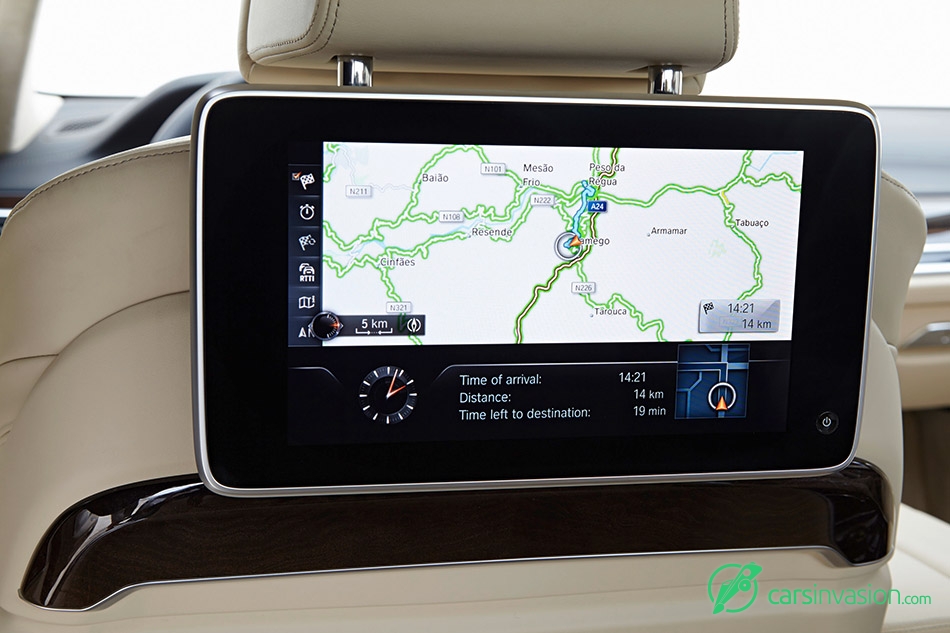
The energy for the electric motor is drawn from a lithium-ion high-voltage battery housed underneath the rear seat where it is very well protected in the event of a crash. It can be recharged by connecting to any standard domestic power socket or a BMW Wallbox, as well as at public charging stations. The eDrive button on the centre console lets the driver adjust the hybrid drive's operating mode. In the AUTO eDrive basic setting, the engine's power is boosted to notable effect by the electric drive when accelerating or during quick bursts of speed. With the MAX eDrive mode engaged, meanwhile, the BMW 740e is able to run purely on electric power, meaning zero local emissions, at speeds of up to 75 mph and for a maximum range of up to 25 miles (BMW 740Le xDrive: up to 23 miles). The driver is also able to select the Battery Control mode, which raises or maintains the high-voltage battery's state of charge as required. In this way, electrical power can be deliberately conserved for all-electric driving later in the journey. Whenever route guidance is active in the navigation system, the predictive power management function calculates a journey-specific strategy for electric driving through to the entered destination. The standard specification for the BMW 740e and BMW 740Le xDrive furthermore includes an auxiliary heating and ventilation system, which is powered by electricity from the high-voltage battery or from the mains supply while charging.
The standard-fit eight-speed Steptronic transmission contributes to further efficiency savings with its wider ratio spread, reduced weight and optimised calibration. A new transmission control system makes for more comfortable shifting and allows the transmission to be linked up with the standard Navigation system. An eight-speed Steptronic Sport transmission with shift paddles on the steering wheel is available as an option (standard on M Sport models), which also features a Launch Control function.
Features such as Brake Energy Regeneration and Auto Start Stop ensure highly efficient energy management. Activating the ECO PRO mode with the Driving Performance Control switch allows use of the coasting function, which decouples the powertrain in overrun phases while travelling at speeds between 31-100mph. This mode's range of functions - which are now individually programmable for the first time - additionally include efficiency-oriented operation of comfort features, efficiency tips, as well as the Route-ahead Assistant, which gives recommendations for an efficient driving style based on the navigation data.
Chassis control and Driving Experience: Comfort and dynamism
With its double-joint front axle, five-link rear axle and Electric Power Steering, the new BMW 7-Series comes with all the right ingredients for precise, assured handling characteristics. The inclusion of a 2-axle self-levelling air suspension system as standard makes a further contribution to the superb ride comfort.
The level control can additionally be operated manually, allowing the vehicle's ride height to be raised by 20mm when driving along a rough stretch of road, for instance. At speeds above approximately 22mph, the level control automatically reverts to its standard setting. When SPORT mode is activated with the Driving Experience Control switch the ride height automatically drops by 10mm when travelling at high speed.
Variable Damper Control is also fitted as standard. The electronically controlled dampers improve ride and suspension comfort at the same time as contributing to the car's dynamic handling qualities. A variety of modes can be engaged using the Driving Performance Control switch.
A new development is the Executive Drive Pro feature. This active chassis control system, which is available for all models with the exception of the BMW 740e and BMW 740Le xDrive, works in unison with the 2-axle air suspension and the Variable Damper Control to achieve a remarkable standard of suspension, damping and vibration comfort. It comprises the newly refined version of the Dynamic Drive system for reducing rolling movement at the front and rear axle. For the first time, active roll stabilisation is now carried out electromechanically, allowing the body roll forces to be equalised particularly swiftly and precisely when taking bends at speed. When driving in a straight line, the adjustable anti-roll bars are set so as to allow the suspension system the greatest possible freedom of movement for increased comfort. What's more, the new system is also more energy efficient compared to hydraulic control, and it also incorporates an anticipatory chassis control function where advance information for regulating the combination of chassis systems is gleaned from the driving style analysis readings, the data from the navigation system and a stereo camera.
A further refined version of the Integral Active Steering system is available as another optional extra. The planetary gearset previously used at the front axle has given way to a variable steering rack ratio, which means that the Integral Active Steering can now also be offered in conjunction with BMW xDrive intelligent all-wheel drive for the first time. By turning the rear wheels in either the opposing or the same direction when steering, depending on the specific driving situation, this system is capable of increasing both manoeuvrability at low speeds and agility during high-paced driving.
For the first time, an ADAPTIVE mode can also be selected via the standard Driving Performance Control switch. With this setting activated, the vehicle set-up is matched to the current driving style and changing route profile in an adaptive, clearly perceptible fashion. With Professional Navigation system as standard, map data is also taken into account.
The Driving Performance Control switch located on the centre console now sports a new design, and drivers have the option of programming an individual configuration for the SPORT and ECO PRO modes via the iDrive operating system.
Interior comfort: the ultimate in style and comfort
The iDrive system's operating concept has been expanded to include the method so familiar from consumer electronics devices: when combined with the standard Navigation system the iDrive operating system's monitor comes in the form of a touch display for the first time. The system can furthermore be specified with the addition of BMW Gesture Control, which is also being premiered in the new BMW 7-Series. By making specific hand movements in the vicinity of the centre console - where a 3D sensor registers them - commonly used infotainment system functions can be controlled very intuitively and conveniently. The various gestures serve, for instance, to adjust the audio volume, control the 3D view display and accept or reject incoming phone calls.
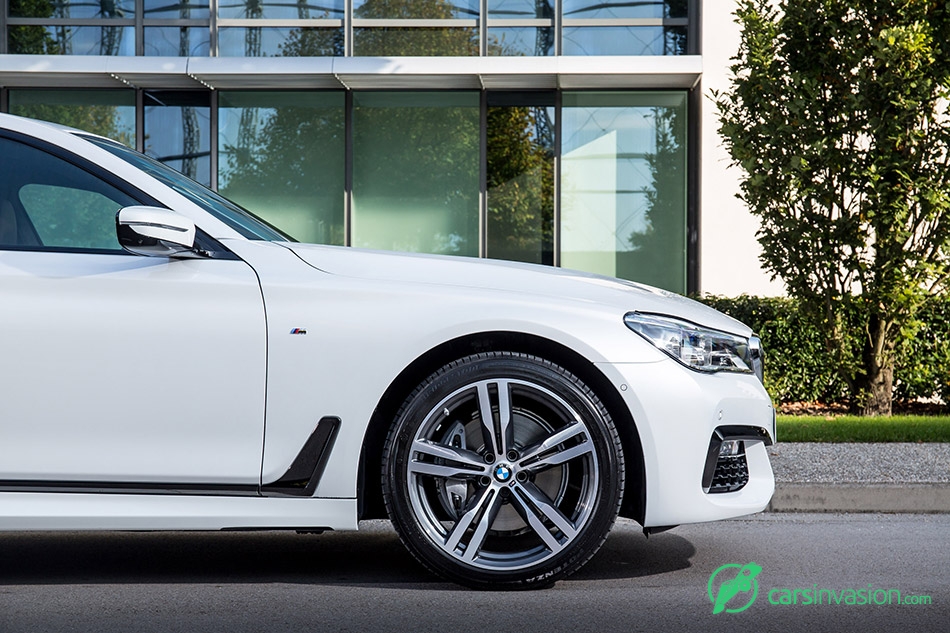
The standard multifunctional instrument display with a 12.3-inch display area alters the graphics and colour scheme used for the cockpit gauges to match the mode selected with the Driving Performance Control switch.
The standard four-zone automatic air-conditioning features a separate control console in the rear and is standard across all BMW 7-Series in the UK. The control panels feature a touch-sensitive surface for the first time: the intensity of the ventilation, the seat climate control functions as well as the fragrance system can all be controlled by touching on-screen buttons. Opting for the Heat Comfort package makes it possible to heat up the steering wheel rim and the armrests in both the doors and the front and rear centre consoles, in addition to the front and rear seats. The Extended rear air-conditioning option for the long-wheelbase models comprises two extra, individually adjustable air vents in the roof liner.
A hands-free phone system complete with Bluetooth audio streaming and USB port is included as standard. A universal holder with an inductive charging facility that is compatible with a range of mobile phones is also equipped as standard. This Comfort telephony with wireless charging includes a holder in the centre console with LED charge status display along with a second microphone to optimise the hands-free functionality for the front passenger.
The massage function for the standard comfort seats offers a choice of eight programs, each with three different levels of intensity, which are designed to relax and stimulate the muscles in regions of the body that can be individually selected. In the rear, it additionally offers a Vitality Programme that has been specially devised for the new BMW 7-Series and allows the passengers to engage in active training to revitalise the body on longer journeys. The training programme instructions are displayed on the Rear-seat entertainment system screens. The massage function is standard for the front seats and an option for the rear.
The Executive Lounge Seating (expected July 2016) provides a superlative standard of travel comfort in the rear seat behind the front passenger seat. The backrest can be reclined to an angle of up to 42.5 degrees. To offer the passenger in the rear even greater legroom, the front passenger seat can be slid forward by an extra 90mm and its backrest tilted all the way forward. For a completely unobstructed view to the front, the head restraint can be folded down as well. An electrically operated fold-out footrest can also be found on the back of the front passenger seat. The rear-seat entertainment system screen can be electrically adjusted to the ideal viewing angle for the rear passenger's current seat position. In addition to all this, the Executive Lounge rear console also features a fold-out table, two cupholders and a storage compartment, as well as the new BMW Touch Command unit.
The latter is a removable tablet with a screen diagonal of 7 inches, which can be used from any seat and even outside the vehicle. It lets the occupants control comfort functions such as seat adjustment, interior lighting and air conditioning, as well as the infotainment, navigation and communication system. It can also be used to play external audio and video files, as a games console or for surfing the internet. A WiFi hotspot built into the vehicle provides the necessary online connectivity. Any content retrieved from the Rear-seat entertainment menu with the aid of the tablet is shown on the Rear-seat entertainment Experience system's two 10.2-inch screens.
The exclusive atmosphere inside the new BMW 7-Series can be further accentuated by attractive lighting design. The standard Ambient lighting provides harmonious indirect illumination in the vicinity of the instrument panel, the door beltlines, the map pockets on the front seat backs, and in the footwells. Courtesy lights and illuminated bars on the door sills also form part of the specification. There is a choice of six different colour variants for the lighting effects, which can be selected in the iDrive menu. Beyond this, there is also a Welcome Light Carpet that produces eye-catching lighting graphics in the entrance/exit area with the help of light sources incorporated into the side skirts.
When specified with the optional roller sunblinds for the rear side windows, the long-wheelbase versions of the new BMW 7-Series are additionally equipped with another new development known as Ambient highlight. Vertically arranged light sources in the B-pillar area illuminate the rear compartment to great effect. The intensity of the lighting can be adjusted by means of contact sensors, as well as from either the iDrive menu or BMW Touch Command.
As an alternative to the electrically operated glass roof that comes as standard in the long-wheelbase versions of the new BMW 7-Series (and as an optional extra in all other models), a two-section Panoramic glass roof with an opening front section is also available. There is yet another option in the form of the Sky Lounge Panoramic glass roof, which uses the light emitted by LED modules to create the magical effect of a starlit sky. As with the Ambient light, there is a choice of six different colour schemes for the lighting pattern. Both the moving glass section and the interior liner are electrically operated on all glass roof variants.
The occupants sense of smell has not been neglected either, with the availability of the optional Ambient Air package. It comprises functions for ionising the air and releasing fragrance into the vehicle interior with selected scents, both of which can be controlled from the air conditioning control console or the iDrive menu. Three levels of intensity can be set, and there are a choice of eight scents in all, two of which can be installed in the vehicle at the same time.
Finally, the Bowers & Wilkins Diamond surround sound system offered as an option brings a fully active 10-channel amplifier, with an output of 1,400 watts, and 16 partially illuminated speakers together to produce an exceptionally precise and wonderfully rich sound in the cabin. In the process, dynamic sound equalizing with three analogue crossovers ensures uniform acoustic performance delivered to all seats.
BMW ConnectedDrive: intelligent connectivity and assistance
The BMW 7-Series has pioneered landmark innovations such as the onboard computer with outside temperature display in 1980, Park Distance Control in 1991 and a built-in navigation system in 1994. With the most extensive range of BMW ConnectedDrive assistance systems and mobility services ever offered for a BMW, the new 7-Series upholds this fine tradition of technical advancement.
In conjunction with the standard Navigation system, and courtesy of the embedded BMW ConnectedDrive Services SIM card, the standard Real Time Traffic Information function eases journeys and also supports interactive traffic sign updating - a world-first.
There's a new-generation Head-Up Display that comes with a 75 per cent larger projection area, while the displayed information and images offer further improved quality and detail and are presented in full colour. And the new BMW 7-Series is the first production car in the world that can be manoeuvred into and out of forward parking or garage spaces without the driver even having to be sitting inside the vehicle. The process is activated by the driver from outside the vehicle using the new standard BMW Display Key and then performed semi-autonomously by the vehicle. This feature is available from November 2015 onwards. In addition, the new version of the optional Parking Assistant makes light work of selecting and manoeuvring into parallel or forward parking spaces.
The optional Driving Assistant safety package has now been extended to include Rear collision prevention and Rear crossing traffic warning. Both these functions use data supplied by sensors at either side of the rear of the vehicle. The Driving Assistant package also includes the Approach control and Person Warning with light city braking function, Lane Change and Lane Departure Warning and Speed Limit Info with no-overtaking indicator. Moreover, the Driving Assistant Plus package also includes not only Active Cruise Control with Stop & Go function and front crossing traffic warning, but also the Steering and lane control assistant including Traffic jam assistant and Lane keeping assistant with active side collision protection.
Active Cruise Control with Stop & Go function has also been extended: when this system is active, drivers can simply press a button to acknowledge speed restrictions detected by Speed Limit Info. The speed setting is then adapted to comply with the detected speed limit.
Night driving enjoyment and safety can be enhanced with the optional systems Adaptive LED headlights with BMW Selective Beam, for maximised high-beam usage, and BMW Night Vision. The Night Vision system, which includes pedestrian and animal protection and a marker light, relays a real-time image to the Control Display showing people, larger animals and other heat-radiating objects. A headlight beam also spotlights the detected objects.
The body and safety: Strong, comfortable, proactive
The Carbon Core makes significant advances not just in terms of weight reduction but also in enhancing the strength and stiffness of the passenger cell. The integral safety concept comprises not only highly resilient supporting structures, but also generous deformation zones and precisely defined load paths that ensure forces generated in an impact are diverted and absorbed extremely effectively.
A comprehensive safety equipment package features front and side airbags, head/curtain airbags for the front and rear seats, active head restraints, three- point inertia-reel seat belts with belt force limiters and belt tensioners in the front seats, as well as ISOFIX child seat mountings in the rear. If a collision looks inevitable, the standard Dynamic Safety system activates the belt tensioners and, if necessary, closes the side windows and the glass roof. The seat backrests are also brought into an upright position to ensure the restraint systems work to best effect.
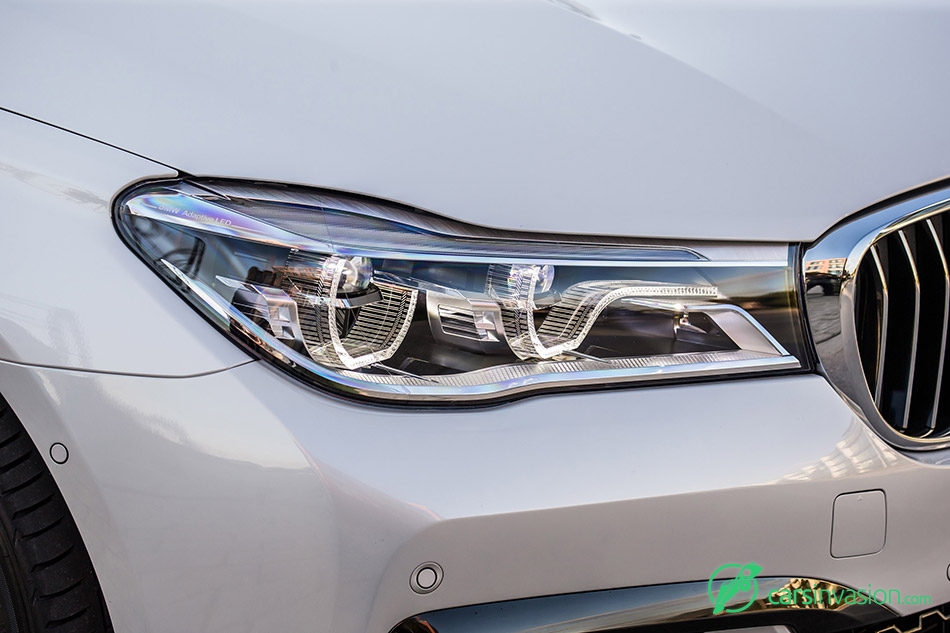
Under the standard electrically operated tailgate a broad, level load space opens up offering luggage capacity of 515 litres. The optional through-loading system provides an aperture into the cabin measuring 20cms wide and 24cms high. The standard Comfort Access feature, includes hands-free opening and closing of the boot lid.
The boot in the BMW 740e and BMW 740Le xDrive models likewise features a level surface and provides 420 litres of space, which far exceeds that of comparable plug-in hybrid models in this segment. Lowering the cover in the rear section of the boot and opening the side storage compartments provides additional stowage space.
The new BMW 7-Series is also the first car in its segment to come with the option of innovative laser headlights including BMW Selective Beam. BMW Laserlights, which had their production-model world premiere in the BMW i8, provide a high-beam range of 600m. Compared to the already extraordinarily powerful LED headlights featured as standard, this signifies a doubling of the range. The risk of dazzling oncoming or preceding road users is reliably excluded by the integrated BMW Selective Beam glare-free High-beam assistant.
BMW Individual: making the new BMW 7-Series your own
Expressive paintwork colours, exclusive light-alloy wheels, choice wood and leather variants and other high-quality details available as ex-factory options all allow considerable personalisation of the new BMW 7-Series.
The market launch of the new BMW 7-Series will be accompanied by a BMW Individual Design Composition for the BMW 740Li model. This will feature BMW Individual paintwork in the new Almandine Brown metallic, combined with the premium features of the exterior design Pure Excellence. The 20-inch forged BMW Individual light-alloy wheels in V-spoke design come in Silver/Ferric Grey bi-colour look.
Inside there's BMW Individual fine-grain Merino full leather in the colour 'Tartufo', which is available for the first time. During the manufacture of this leather upholstery, carefully selected, unblemished raw materials are processed using especially gentle techniques. As a result, the leather used for the seats, door trim panels, lower instrument panel section, centre console, armrests and door pulls retains its natural open-pore structure. The soft, fine-grain surfaces remain breathable and provide supreme comfort. Hand-woven piping and woven-look quilting feature on the seat surfaces, and to match this, the floor covering and floor mats, seat belts and BMW Individual Alcantara headliner also come in Tartufo. There are also door sills with illuminated BMW Individual lettering, BMW Individual interior trim strips in Piano Finish Black and a BMW Individual leather steering wheel with fine-wood applications in the same finish.
In addition to the above, the BMW Individual Design Composition includes the BMW Head-up Display, Surround View, the panoramic glass roof, Active seat ventilation in the front, the Heat Comfort package, the Harman Kardon surround sound system and the Rear-seat entertainment Experience.
Other options available from BMW Individual include the BMW Individual high-gloss Shadow Line for the exterior, the BMW Individual Anthracite headliner, the BMW Individual cool box, the BMW Individual Alcantara headliner and BMW Individual rear reading lights with gimbal-mounted light sources in the headliner.
Production: building on history at Dingolfing
Since the launch of the first model generation in 1977, the BMW 7-Series has been made on the assembly lines of BMW Group Plant Dingolfing. This production facility not only possesses the tradition for building BMW's top-of-the-line models, but also plays an important role as a centre of competence for lightweight construction. For example, the aluminium bodies for Rolls-Royce models are produced in Dingolfing, as are drive and chassis components for other BMW production plants. The factory in Lower Bavaria supplies both the aluminium chassis and the high-voltage batteries - along with other electric drive components - for the BMW i models which are assembled at BMW Group Plant Leipzig.
Source: BMW

